Indoor palms: varieties and rules of care

Indoor palms can be a worthy decoration for any space - both at home, and in a large office, and in a shopping center. You just need to choose the right types and take into account the characteristics of each plant. It is also necessary to pay attention to the observance of the rules of care and reproduction.


Peculiarities
The house palm is no less attractive houseplant than the recognized leaders in landscape design. It is a range of cultures associated with the warmth of summer and the serene tranquility of tropical latitudes. Taking care of such ornamental plants is not as difficult as beginner growers believe. Subject to standard conditions, palm trees can become an excellent filling of any interior.
Depending on the species, the geometric shape of the representatives of the palm family can be very different.
You can choose specimens with different growth rates, determined by your own needs. It is possible to regulate the growth rate by varying the light intensity.


Species overview
Each type of indoor palm has its own specifics. Therefore, any consumer will be able to choose the perfect plant in accordance with their needs.
Brachea
In some sources, this plant is also called bragea, but such a spelling is less and less common in our country. Although it should be recognized as correct, since the species was named after the famous astronomer Tycho Brahe. The height of trees can reach 12 and even 15 m. The trunk of this variety of ornamental plants is bare from below. The foliage is similar to rounded fans, with deep dissection into segments.

The inflorescences of this culture resemble a complex panicle. Their length reaches 5 m. There are both smooth and spiked petioles. The yellow-green flowers are collected in groups of 3. The brachea fruit is shaped like an egg or a ball.
They always have a fleshy membrane. In nature, this plant inhabits Guadeloupe, the mountainous arid regions of Mexico and other countries of Central America.
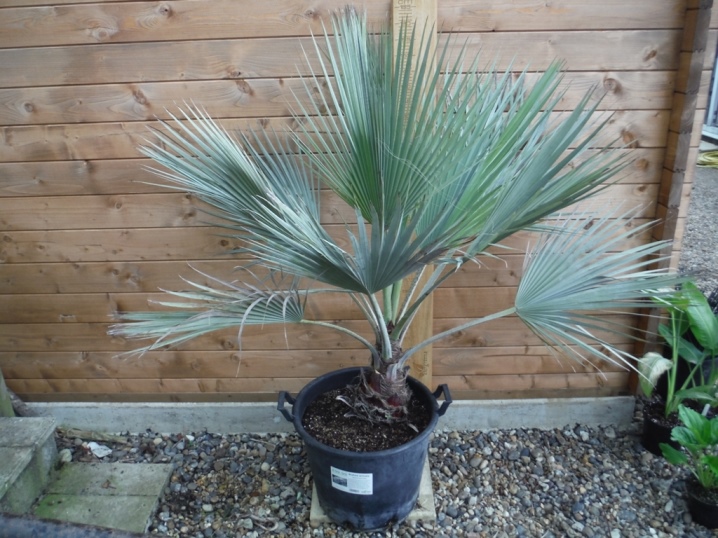
Butea
This species is also named after one person, but already a Scottish nobleman. Butya capitate is a bright representative of the palm family; this genus includes about 20 species. Its natural habitat is various countries of South America. The leaves always have a feathery structure, by which they are distinguished. The height of a palm tree can reach 6 m with a trunk girth of up to 50 cm.

Karyota
This genus of palm trees with thin leaves that have a ragged edge are very attractive in everyday life. In total, the group includes 12 species. Unlike previous genera, it comes from Southeast Asia and the shores of the Indian Ocean. For your information: some types of these palms are traditionally used for wine and sugar production.
In our country, you can expect to grow indoor and soft types of karyota. Under natural conditions, they can rise up to 10 m. Growth occurs rather quickly, but, if necessary, it is always easy to slow down it with ordinary agronomic manipulations.
There are also shrub varieties of culture. All her leaves are of the double-pinned type.

Washingtonia
Describing palm-like plants, one cannot ignore the culture that owes its name to the American capital. In nature, this genus rises up to 30 m.But only specimens no larger than 2 m can be grown at home.
Important: this whimsical plant is much more capricious than other indoor palms.With illiterate treatment, it can even die altogether.

Washingtonias grow with broad, fan-like leaves. In a home culture, this culture will not bloom and bear fruit. Since it is brought from warm regions, it will take a long, scrupulous acclimatization.
Important: the plant will be able to withstand frosts down to –12 degrees, but only for a short time. Botanists distinguish 2 types of washingtonias - filamentous or filamentous and strong (robusta).

Gioforba
It also has an alternative name - bottle palm. This name is given for the special geometry of the barrel. Culture is not suitable for apartments and offices. However, experienced growers may perceive gioforba not as an obstacle, but as a challenge. It is worth considering that such plants are very rare - they may become extinct in the coming years.
Gioforba grows slowly. If 1 leaf appears every year, this is already a good success. It is impossible to grow specimens larger than 2 m in a pot. The plant has a very thermophilic disposition. Already at zero degrees, it suffers greatly.

Goveya
These plants (sometimes also called hovea) are in great demand among gardeners. They began to grow them in room culture back in Victorian England. For your information: in nature, you can meet Govea only on the Australian island of Lord Howe... Both species of this genus grow up to 3-5 m in indoor conditions. In this case, they most often stop at a lower figure.

Important features of the culture can be considered:
- a large number of upper stems;
- extremely slow growth (up to 3 leaf plates per year);
- ease of growing;
- the ability to achieve a beautiful look only with careful care.

Livistona
Once again, a palm tree named after a Scottish nobleman, but without a formal title, is next in line. It represents trees up to 25 m high.The diameter of the leaves is 0.6-1 m. They are characterized by a dark green, less often gray-green color. The dormant period for Livistons is not very typical; instead of a trunk, a mass of leaf plates is formed in it.

Rapis
This type of plant is very suitable for small apartments and small private houses. Moreover, it will look spectacular outwardly. For room culture, low rape is often used; tall rape is less suitable for home cultivation, but it is useful in the office, where you can put a tree with a height of 3 m.
Rapis is extremely light-requiring. This plant requires normal room temperature.

Ropalostilis
This palm tree comes from New Zealand. It is characterized by a slender trunk, on which rings from fallen leaves remain. When flowering ends, small round fruits appear. They are colored red. Only young ropalostilis are grown in the rooms, since the height of adult specimens reaches 10-12 m.

Sabal
The sabal genus includes 16 species. The height of the trunk can be up to 25-30 m in nature. Moreover, its diameter will be up to 60 cm. Evergreen leaves are similar in shape to a fan. The rachis rod gives the foliage an increased strength.

The plant colonizes:
- Colombia;
- Mexico;
- Venezuela;
- other countries of Central America;
- Bermuda;
- south and southeast of the United States.


Trachikarpus
The height of the trunk reaches 12 m. Its diameter ranges from 15 to 20 cm. Nine species are now distinguished in the genus of trachycarpus. The length of the branched inflorescence is up to 1 m.Forchun's trachycarpus predominates in domestic culture, the height of which does not exceed 2.5 m.
Other information:
- optimal growth in partial shade;
- mandatory high humidity;
- some slowdown in growth during the winter months.

Date
This plant is colloquially called a date. The culture was known on the territory of modern Iraq 6 thousand years ago. Date palms can be both trees and tall shrubs. Among them, varieties with several trunks predominate. Dates are often grown from seed at home.
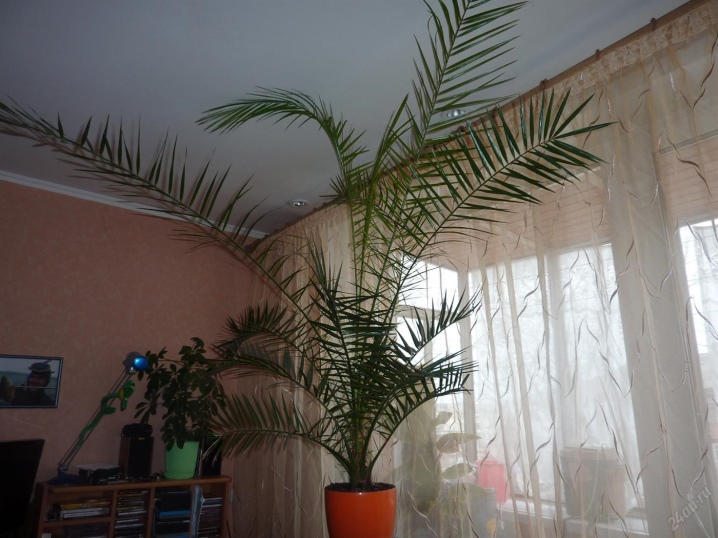
Hamedorea
The genus Chamedorea includes at least 100 different species. The main area is the south and center of the American continent. All varieties of hamedorea are undersized shrubs with a rhizome structure. Outside the natural zone of settlement, a "graceful" species and Ernest-August's chamedorea are grown. Both varieties tolerate deep shading well.
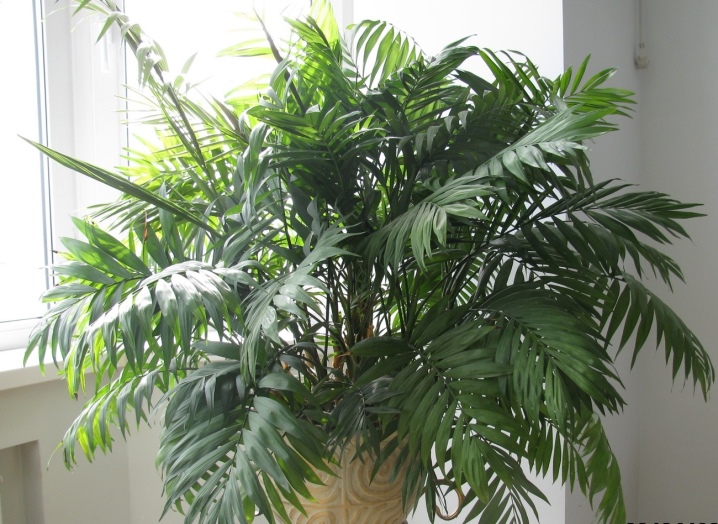
Hamerops
This genus of indoor palms is represented by one species only. And this is the only plant of this family that can be found in Europe. The trunk reaches a height of 4-6 m. Flowering covers April, May and June. The plant develops prickly petioles.

The list of possible types of indoor palms is not limited to this.
Bethel variety sometimes referred to as areca palm; the name can be abbreviated to the simple "areca". But such a reduction is not entirely botanically correct. The height of betel trees can be 30 m. The trunk is always straight, without noticeable branching.

Hawaiian culture, or brigamia, for its shape it can also be called a volcano palm. It is curious that some time ago this species was on the verge of extinction. The situation was saved by the efforts of ecologists and climbers, who had to manually pollinate the plants. An equally interesting feature for flower growers is that it is a succulent. Hawaiian palms are characterized by a fleshy stem of a brownish-green or silvery-ash color.
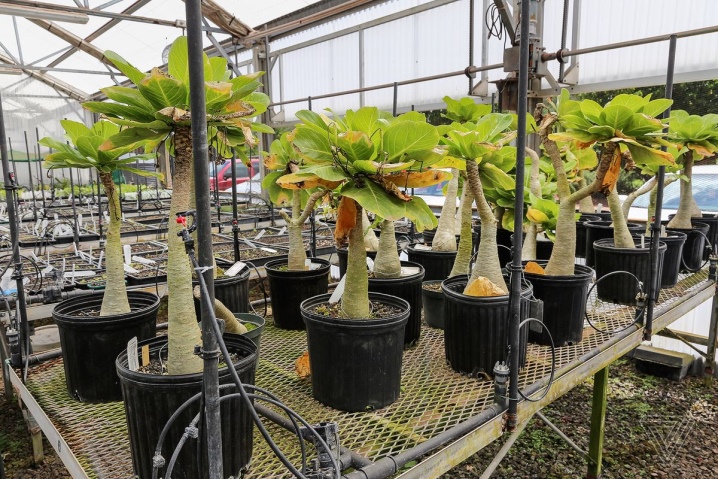
The genus pandanus, or in another way the spiral palm, unites at least 750 plant species. They are most commonly found in the tropical regions of the Eastern Hemisphere. There is also a pandanus in Madagascar, and at least 90 species grow there. They are able to adapt even to very difficult and varied environmental conditions: on the banks of rivers, in the forests of the alpine zone, on the slopes of volcanoes and in swampy areas. All year round, you will have to maintain the temperature not lower than +19 and not higher than + 25 ° С.


The water palm, or rather the water palm, is a culture with phenomenal resistance to negative conditions. It is more of an aquarium plant that clings to the bottom. It has nothing to do with real representatives of the palm family. But it winters excellently even during a very harsh winter. The purchase and planting of the aloe-like telores (this is the botanical name) is possible during the entire warm season.

Care rules
Taking care of a room palm is not too difficult. It is recommended to plant such plants in conservatories, as optimal conditions are created there.
Important: buying an adult plant is impractical. With a sharp change in the parameters of the external environment, it can hurt and even die. As a planting material, it is advised to use a special soil, which is called “for palm trees”.

A very important role in growing such plants at home in a pot is the tranquility of the culture. It is necessary to decide on a transplant only as a last resort, when there are no other options. If you have to transplant a tropical guest, the clod of earth around the root should be kept intact. The missing soil is poured on top. Spraying indoor palms is encouraged, but it must be handled with care.
This procedure is carried out normally only in the summer. In any other season, wet leaves become easy prey for pathogenic microbes. Be sure to choose a bright room. But some types of palm trees do not tolerate direct sunlight, and therefore you need to take care of protection with curtains, muslin.
Important: where the palm tree is located, regular ventilation is required.

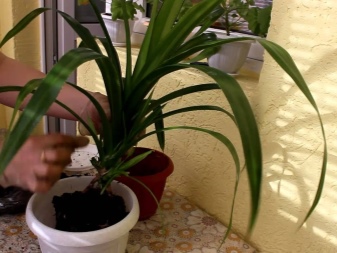
Other requirements:
- you need to water palm trees only with soft water;
- select the frequency of watering individually, taking into account the characteristics of the plant;
- do not clean the leaves with a hard cloth or synthetic detergents;
- organic mixtures for deciduous ornamental crops should be used as top dressing;
- feed should be done only after the soil is moistened;
- you can not feed the palm tree in the fall and during the winter months;
- after transplanting, take a break for 2 months before the next feeding.


Breeding options
Almost 100% of palm species can be propagated by seed. For Washingtonia, Liviston, Hovea, Trachycarpus and Licuala, this is the only breeding option. At the same time, the shelf life of the planting material is critical, since its germination is limited. The outer shells are removed from the seeds, if they are still there. The rest is kept in warm water for several days, achieving swelling.
When soaking, it is necessary to keep the planting material in a warm place at a temperature of about + 30 ° C. The water can be changed as needed. You can sow in:
- boxes;
- jars;
- disposable cups made of food grade plastic.


The optimal substrate is 2 parts of garden soil and 1 part of washed heated sand. Put sand on top. It is necessary to immerse the seeds in it by 2-3 cm. So that the soil is not washed out during watering, it is carried out by spraying. The planting containers are covered with polyethylene to create a greenhouse effect.
After the emergence of seedlings, the planting containers are rearranged to a more illuminated place. However, direct sunlight is contraindicated at this time.
The offshoots are taken from the roots located near the surface. After rooting, the new plant is separated with a well-sharpened knife.
Reproduction in parts of the tops is not practiced, but this approach is possible in crops that look like palm trees.


Plants that look like a palm tree
Dracaena is a genus belonging to the asparagus family; these are succulent trees or shrubs. More than 100 plant species are found in the genus of botany. Dracaena mainly grows in Africa. And there are also representatives of this genus:
- in China;
- in Mexico;
- in the Australian Queensland;
- in the east of the Himalayas;
- in Taiwan;
- in Cuba;
- in Costa Rica.

There are other false palms (aka palm-like plants). They are attractive because they are less demanding in terms of climate, and domestic breeders have much more chances of seeing a flower than when growing true palms. Yucca successfully competes with dracaena in popularity. In a domestic culture, it grows relatively slowly. Yucca tolerates drought well, but can be severely affected by excessive moisture.

A good alternative can also be:
- pakhira;
- bent nolina;
- cordilina.



Beautiful examples
The photo shows a chain of indoor palm trees. Their graceful foliage immediately adds charm to a separate corner of the house.

The date palm can be just as beautiful. It looks beautiful against a light background next to a black armchair.

Govea is also an excellent candidate for indoor space, as evidenced by this photo; however, it will look more beautiful and more logical in larger rooms.

For the care of indoor palms, see the next video.































The comment was sent successfully.